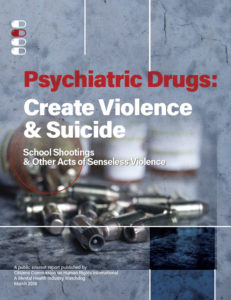Acts of senseless violence linked to increasing psychotropic drug prescriptions—report documents 100 incidents associated with 500 deaths, urging greater consumer awareness and better informed consent
By CCHR International
The Mental Health Industry Watchdog
July 13, 2021
With increasing reports of acts of senseless violence in the community, the mental health watchdog, Citizens Commission on Human Rights International (CCHR) is updating its report sourcing thirty studies linking psychotropic drugs to hostility, mania, aggression, self-harm, suicide and homicide. As a public service to consumers and a resource for law enforcement, an addendum to its report on the issue will further highlight the influence of psychotropic drugs in inducing violence, suicide and physical disability.
The 64-page report, Psychiatric Drugs Create Violence and Suicide, details about 60 examples of school and other mass shootings and senseless violent acts committed by those under the potential influence of psychotropic drugs or from their withdrawal effects.
New research shows that since 1992, there were at least 100 school- and community-related acts of violence implicating psychotropic drugs, resulting in nearly 510 killed and 930 wounded.
Antidepressants were the most implicated in these examples, followed by anti-anxiety-sedative drugs, antipsychotics, and, then stimulants.
Researchers reviewing the Food and Drug Administration Adverse Event Reporting System identified 31 prescription drugs that are disproportionately associated with violence, and of these, 25 or 80% were psychotropic drugs.[1] Their findings, published in Public Library of Science ONE, included 11 antidepressants, six sedative/hypnotics, four antipsychotics, three drugs for treatment of attention deficit hyperactivity disorder (ADHD) and one mood stabilizer. Cases of violence included: homicide, physical assaults, physical abuse, homicidal ideation, and cases described as violence-related symptoms.[2]
CCHR says mass violence gets reported as being caused by rising rates of “mental illness,” but there’s no evidence of this and such claims lead only to demands for more mental health funding and tougher involuntary detainment laws that CCHR says exacerbates the problem when the mental health system relies on a biomedical paradigm. The World Health Organization recently criticized coercive psychiatry and forced hospitalization and treatment. It called for countries to ensure that “informed consent” is in place, which CCHR says must include consumers made aware of the violent and suicidal side effects of prescription psychotropics.[3]
A review of scientific literature published in Ethical Human Psychology and Psychiatry reveals that since 1955, the introduction of psychotropic drugs correlates with an increase in acts of violence.[4] Researchers determined that “psychoactive drugs, in particular the atypical antipsychotics and SSRI antidepressants, have not only failed as therapies for the mentally ill – these irresponsibly prescribed drugs have led to an epidemic of chronic, incapacitating mental illness. Inasmuch as the drugs induce mania and akathisia [uncontrollable restlessness], patients are at increased risk of violent, aggressive, and suicidal behavior.”[5]
The drugs can also cause iatrogenic sickness. They produce abnormal metabolic effects resulting in chronic physical illnesses that require additional drugs. They can increase cholesterol levels and high blood pressure, cause hormonal and cardiac abnormalities, and diabetes.[6]
According to a national U.S. research group, “the evidence from government sources demonstrates that instead of improving patient recovery rates, hundreds of thousands of patients treated with these drugs have been rendered incapable of recovery. Patients on the drugs have been condemned to become permanently disabled.”[7]
For example, as reported in the Journal of Clinical Psychiatry: “Antidepressant-induced mania is not simply a temporary and reversible phenomenon, but a complex biochemical mechanism of illness deterioration.”[8]
Psychiatric Times also reported “comparative data are emerging on the metabolic effects of second-generation antipsychotics (SGAs) used in treating children and adolescents….” The data shows: “Increased insulin resistance in young people after three months of treatment” with three antipsychotics.[9]
Although psychotropic drugs may appear to provide short-term relief for emotional and behavioral issues, consumers need to weigh up the risks, including chronic disability. Further, not everyone is going to experience violent side effects, but be aware that a percent will.
At least 27 international drug regulatory agency warnings link psychiatric drugs to mania, violence and homicidal ideation (thoughts or homicide fantasies). Another 22 warnings linked the drugs to aggression and hostility.[10]
Withdrawal effects also include violent and suicidal reactions. Post-withdrawal symptoms from psychotropics “may last several months to years” and include disturbed mood, emotional lability [excessive emotions and frequent mood changes], and irritability, according to a study published in Psychotherapy and Psychosomatics. [11]
Withdrawal from sedatives, also known as anti-anxiety drugs or benzodiazepines can last weeks and sometimes months or even years. Adverse effects can include increased anxiety, perceptual distortions, depersonalization, paranoid thoughts, rage, aggression, and irritability.[12]
CCHR stresses that no-one suddenly stop taking any psychiatric medication but to withdraw safely only under medical supervision. People wishing to come off psychotropic drugs should be supported to do so, WHO’s report says.
CCHR is responsible for more than 190 laws that protect consumers or ensure accountability for mental health abuses. CCHR’s psychiatric drugs side effects database was created for easy public use.
References:
[1] Thomas J. Moore, Joseph Glenmullen, Curt D. Furbert, “Prescription Drugs Associated with Reports of Violence Towards Others,” Public Library of Science ONE, Vol. 5, Iss. 12, Dec. 2010, http://www.plosone.org/article/info%3Adoi%2F10.1371%2Fjournal.pone.0015337
[2] Ibid., Thomas J. Moore, Joseph Glenmullen, Curt D. Furbert, Public Library of Science ONE
[3] https://www.cchrint.org/2021/06/11/world-health-organization-new-guidelines-are-vital-to-end-coercive-psychiatric-practices-abuse/, citing: “Guidance on Community Mental Health Services: Promoting Person-Centered and Rights-Based Approaches,” World Health Organization, 10 June 2021, p. 6 https://www.who.int/publications/i/item/9789240025707
[4] “Anatomy of an Epidemic: Psychiatric Drugs and the Astonishing Rise of Mental Illness in America,” Ethical Human Psychology and Psychiatry, Volume 7, Number I, Spring 2005, https://freedom-center.org/pdf/anatomy_of_epidemic_whitaker_psych_drugs.pdf
[5] Vera Hassner Sharav, “Anatomy of an Epidemic: Psychiatric Drugs and the Astonishing Rise of Mental Illness in America,” AHRP, 26 Oct. 2006, https://ahrp.org/anatomy-of-an-epidemic-psychiatric-drugs-and-the-astonishing-rise-of-mental-illness-in-america-whitaker/
[6] Ibid.
[7] Ibid.
[8] Ibid., citing: Fava, G. Can long-term treatment with antidepressant drugs worsen the course of depression? Journal of Clinical Psychiatry, 2003, 64, 123-133
[9] Ibid., citing: Correll CU, Olshanskiy V, Mughal T et al. (2005), Prospective study of second-generation antipsychotic-induced insulin resistant in antipsychotic-naive children and adolescents. Presented at the XX International Congress on Schizophrenia Research. Savannah, Ga., April 2-6
[10] https://www.cchrint.org/school-shooters/; https://www.cchrint.org/psychiatric-drugs/drug_warnings_on_violence/
[11]“Patient Online Report of Selective Serotonin Reuptake Inhibitor-Induced Persistent Post-Withdrawal Anxiety and Mood Disorders,” Psychotherapy and Psychosomatics, 19 Jan. 2012, https://www.karger.com/Article/FullText/341178
[12]. C. Heather Ashton, DM, FRCP, “Benzodiazepines: How They Work and How to Withdraw,” Institute of Neuroscience, Newcastle University, Newcastle upon Tyne, 2002, http://www.benzo.org.uk/manual/bzcha03.htm




SHARE YOUR STORY/COMMENT